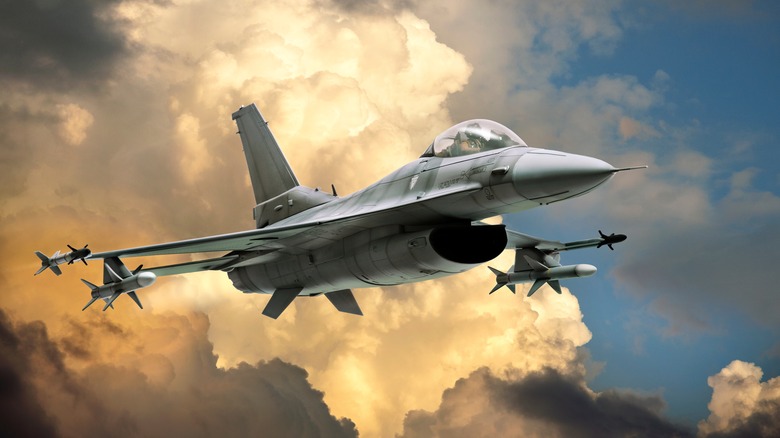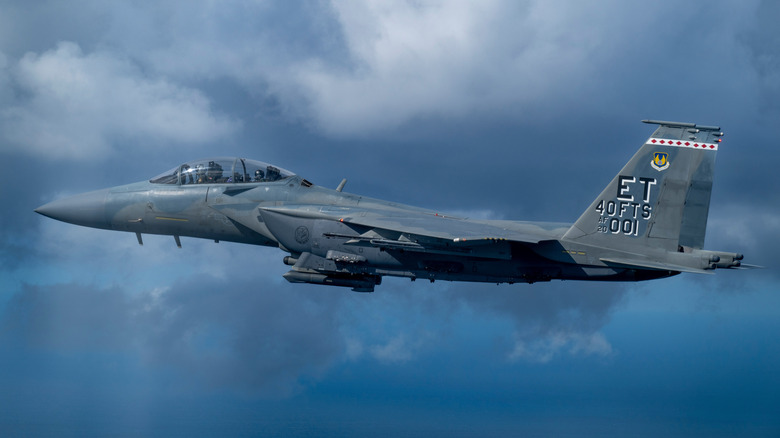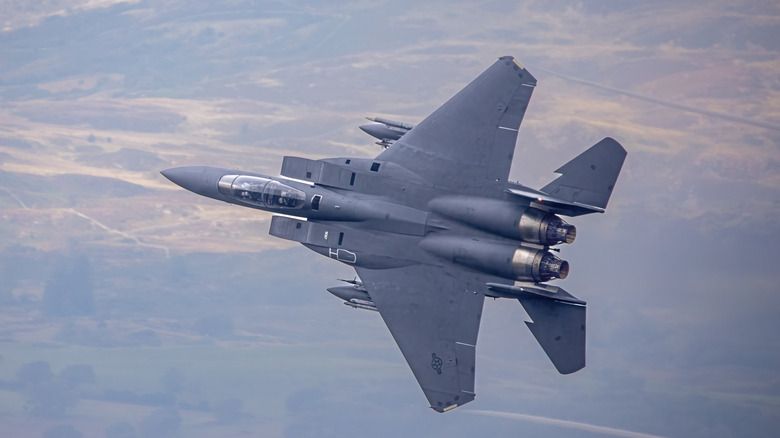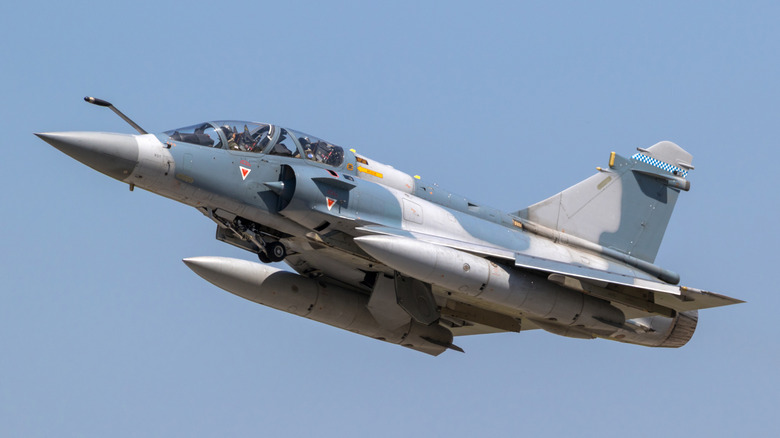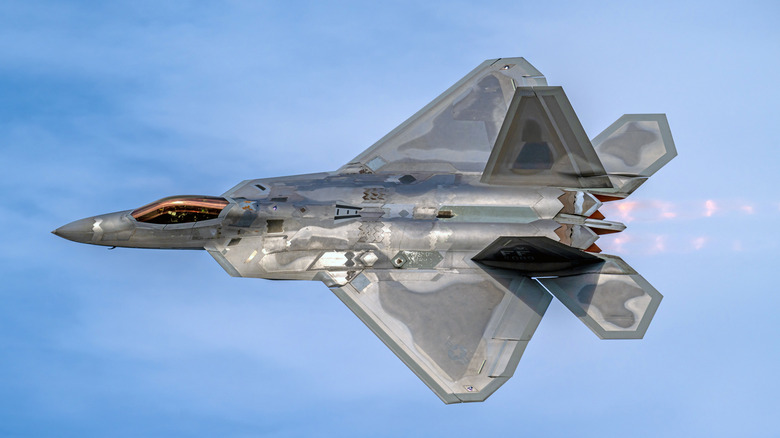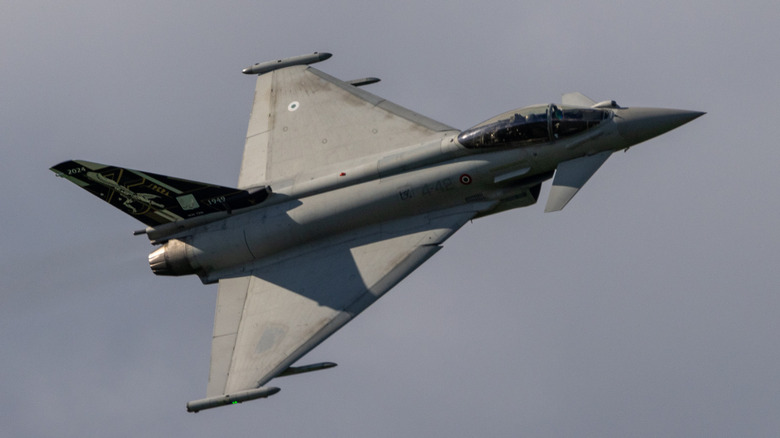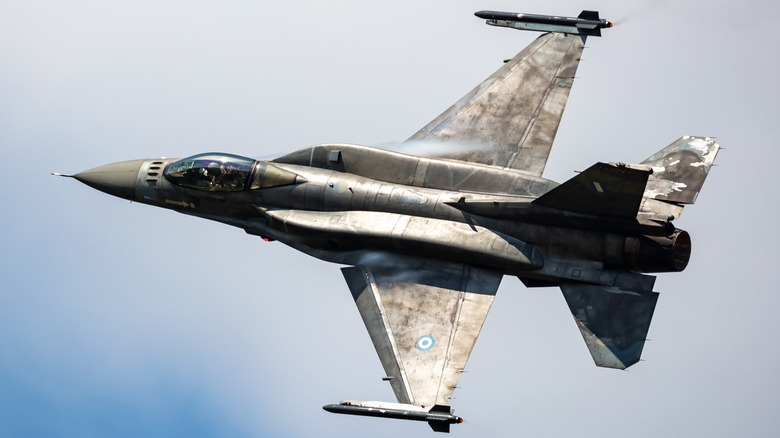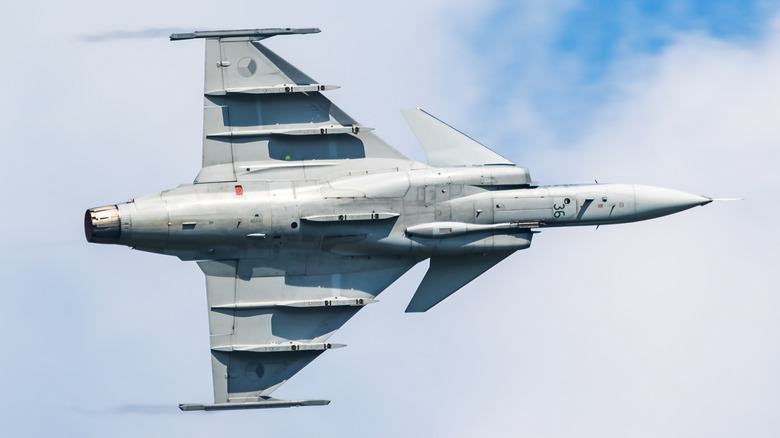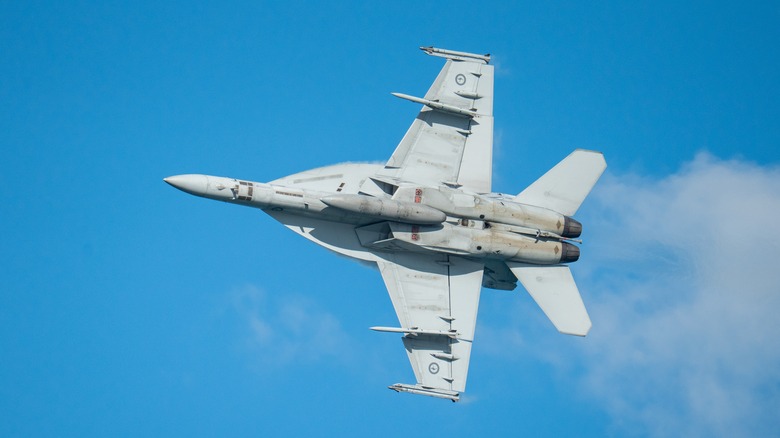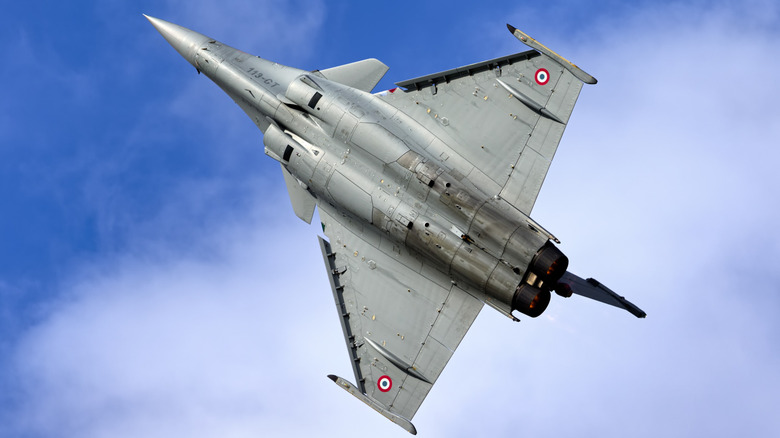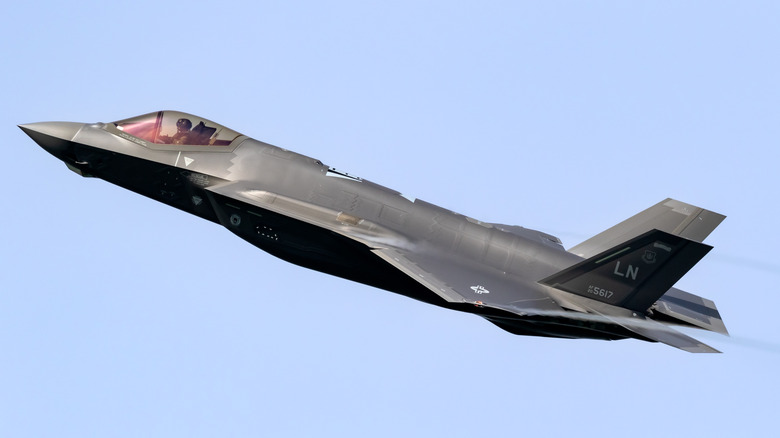10 Of The Fastest NATO Fighter Jets, Ranked By Top Speed
Since the world came across the first fighter jet — the Me 262 used by the Germans in 1944 at the end of WWII — it has known how great a power aerial warfare could be. It showed what speed combined with firepower could do for a country in war. The U.S.'s first fighter jet — Lockheed P-80 Shooting Star — was introduced in 1945. Today, after several years of evolution of fighter jets, they have become an integral part of any country's military armory. With time, countries came together in groups to respond to threats from enemy nations. NATO (North Atlantic Treaty Organization) was established on April 4, 1949, and has 32 member countries hailing from Europe and North America.
NATO allies have some top-notch fighter jets from the U.S. and European makers. However, because America has a strong history and know-how in making high-level fighter jets, most of the NATO fighter jets are from the U.S. 24/7 Wall St. says that the U.S. has 10 times more fighter jets than the next NATO ally, Turkey. Some specific jet models are more common and popular because they are loaded with different airborne capabilities. Warplanes are not just made to operate at blistering speeds thousands of feet above the ground; they can also fly at low altitudes, which is a major need for combat missions and precision strikes.
This list ranks the 10 fastest NATO fighter jets by their top speeds. Notably, only fighter jets that saw active service were included.
Boeing F-15EX Eagle II (Mach 2.5)
The F-15EX Eagle II, built by Boeing in 2021, is a massively upgraded version of the original McDonnell Douglas F-15 Eagle. Since the original F-15 Eagle is a favorite of many countries, the F-15EX Eagle II has big shoes to fill. Boeing is reportedly planning to accelerate the production of the F-15EX Eagle II, with an intent to upgrade the U.S. Air Force fleet with the latest generation jets. Aside from America, a top consumer of the Boeing F-15EX Eagle II fighter jet, several countries, including Israel, Qatar, Japan, Saudi Arabia, and even NATO country Poland, are expected to get their F-15EX Eagle II deliveries very soon.
The Boeing F-15EX Eagle II can reach a top speed of Mach 2.5 with two General Electric F110-GE-129 engines. It has a payload capacity of 29,500 pounds and a range of 2,762 miles, better than any other fighter jet in the U.S. Air Force. The F-15EX Eagle is 63.8 feet long, 18.5 feet tall, and 42.8 feet wide. This fighter jet has a ceiling of 60,000 feet and an empty weight of 31,700 pounds while sitting in the hangar. The maximum load it can take off with is 81,000 pounds.
One of the key features of the F-15EX Eagle is that it is equipped with plug-and-play Open Mission Systems (OMS) architecture, which makes upgrading or replacing software, sensors, or weapons relatively easy. As production picks up pace, it could become one of the standard NATO fighter jets.
McDonnell Douglas F-15 Eagle (Mach 2.5)
With over 50 years of history, the McDonnell Douglas F-15 is one of the best NATO fighter jets ever built. This jet entered service in the mid-1970s and has been the primary fighter jet for the U.S. Air Force since then. Multiple variants of the F-15 Eagle have been manufactured during its lifespan, with the first being the F-15A/B. The Boeing F-15EX Eagle is the latest version of the F-15 Eagle, filled with many technical advancements. Speaking of the original, the F-15 Eagle could reach top speeds of up to Mach 1.6 at 10,000 feet and around Mach 2.5 at 45,000 feet.
The F-15 Eagle is powered by two Pratt & Whitney F-100 afterburning turbofan engines, each providing 25,000 pounds of thrust. It measures 58.2 feet long, 16.6 feet high, 42.10 feet wide, and has an empty weight of 58,000 pounds. The Eagle could be loaded with various weapons, including an M61A1 20-millimeter Vulcan cannon, AIM-7 Sparrow, and AIM-9 Sidewinder missiles, along with 15,000 pounds of extra missiles and bombs. This jet has a range of 3,450 miles thanks to a high engine thrust-to-weight ratio.
It was also loaded with advanced avionics and sensor technology, such as a heads-up display visible in all lighting conditions and a Doppler radar system that allowed the fighter jet to look up and down without getting misguided. The F-15 also has advanced communication, navigation, and electronic warfare systems that can detect an enemy or foe automatically.
Dassault Mirage 2000 (Mach 2.2+)
NATO member France, along with the U.S., is also a respected country for manufacturing advanced fighter jets. The Mirage 2000 is a French single-engine, fourth-generation fighter jet built by Dassault Aviation. It currently serves in the fleets of many countries, including India. Developed with an aim to replace the Mirage III, the first Mirage 2000 prototype took to the sky on March 10, 1978. However, it took six more years for the jet to enter service in the French Air Force in 1984. According to Dassault, out of the total 600 Mirage 2000s, 50% were exported to countries such as Brazil, India, Egypt, Peru, Qatar, Taiwan, and the UAE.
The Mirage 2000 is a versatile fighter jet available in different versions, including the Mirage 2000B, 2000C, 2000N (the nuclear version), and 2000D. Regarded as one of the prominent NATO fighter jets, the Mirage 2000 can reach a top speed of Mach 2.2+. The power comes from an SNECMA M53 turbofan jet engine that delivers around 20,000 pounds of thrust. It is 47 feet long, 29.9 feet wide, and can climb at 60,000 feet. Mirage 2000 comes with a couple of 30-millimeter guns fitted internally and can take an extra load of up to 38,500 pounds.
Thanks to its delta wings, the Mirage 2000 gets its maneuverability and stability at higher altitudes. The first French fighter jet featured fly-by-wire controls, replacing traditional buttons with electronic signals. It was equipped with the Thomas-CSF Radar Dopper Multifunction system, making it a star in air-to-air and air-to-ground combats.
Lockheed Martin/General Dynamics F-22 Raptor (Mach 2.25)
The F-22 Raptor, built by Lockheed Martin, is one of the company's best fighter jets. This made in the U.S. stealth fighter jet replaced the F-15 and F-16 aircraft towards the end of the Cold War. The F-22 Raptor took off for the first time on September 7, 1997, and the U.S. Air Force considers the F-22 Raptor an unmatched aircraft even today. The F-22 features one of the most advanced cockpits ever made for a fighter jet, and its gold canopy adds to its stealth, making radars hard to detect.
Although NATO countries would have appreciated the Lockheed Martin F-22 Raptor in their arsenal, it is exclusively available to the U.S. For its ultimate performance in a joint military exercise, the Northern Edge, the F-22 Raptor was awarded the prestigious Collier Award in 2006. Stealth fighter jets are as good as their speed, and the F-22 Raptor is no joke. The two Pratt & Whitney F119-PW-100 turbofan engines produce 35,000 pounds of thrust individually and give the F-22 the boost to reach a top speed of Mach 2.25.
The F-22 Raptor is also a Hollywood favorite and has appeared in movies like Iron Man 2, Civil War, Captain Marvel, Olympus Has Fallen, The Butterfly Effect, and many more. Even though the production of the was shut down in 2012 to make way for the F-35 Lightning II, a newly developed sensor package is expected to keep the F-22 in service until the 2040s.
Eurofighter Typhoon (Mach 2.0)
It's not just America that has cracked the formula for manufacturing some of the world's best fighter jets. The Eurofighter Typhoon is officially the world's most advanced swing-role combat aircraft. It is a collective effort by NATO nations, Spain, Germany, Italy, and the United Kingdom. Built by Airbus, BAE Systems, and Leonardo, this NATO fighter jet took its maiden flight in 1994. Between 2003 and 2005, it entered service in the Air Forces of the four core nations that built it. Austria was the first country to which the Eurofighter Typhoon was exported.
This all-weather, all-European Eurofighter Typhoon fighter jet can reach a top speed of Mach 2.0 and has a ceiling of 55,000 feet. This feature-loaded combat aircraft is designed with aerodynamics in mind and can tackle enemies in the air and ground. One of the highlights of the Eurofighter Typhoon is that it beats the F-22 Raptor in terms of range (Typhoon's 2,356 miles as opposed to the 2,259 miles of the F-22). Out of the total 680 Eurofighter Typhoons, 603 units have already been delivered, making it the mainstay of NATO's eastern edge.
It is fitted with two Euro Jet 200 engines, made by Rolls-Royce, MTU, Avio Aero, and ITP Aero, and offers 20,000 pounds of thrust. The 15% metal body enhances its stealth and protects it from radar detection. It has an E-SCAN sensor, a Pirate Infrared Sensor, a Multifunctional DID system, a Defensive Aids Subsystem, Identification of friend or foe, a heads-up display, and other advanced features.
Lockheed Martin/General Dynamics F-16 Fighting Falcon (Mach 2.0)
The General Dynamics F-16 Fighting Falcon, previously Lockheed Martin F-16 Fighting Falcon, has been ruling the skies for the U.S. since it entered service in 1979. Over 3,000 F-16s are currently providing their services for 29 countries, with the U.S. and other NATO nations such as the Netherlands, Norway, and Denmark acting as its major customers. The F-16 was a result of a joint consortium between the U.S., Belgium, Denmark, the Netherlands and Norway. Built to be agile, effective, and adaptable, all by keeping the maintenance and production costs low compared to the then-existing aircraft, the F-16 has proven to be one of the world's most reliable fighter aircraft for many countries over its 50+ years of service.
The Lockheed Martin F-16 Fighting Falcon is powered by a single engine, either a General Electric F110-GE-129 or a Pratt and Whitney F100-PW-229. There is an anti-fire system available as part of its internal system. This impressive aircraft can reach a top speed of Mach 2 and has an empty weight of 9,000 kilograms. In terms of size, the F-16 measures 15 meters in length, 10 meters in width and five meters in height. It boasts a maximum ceiling of 55,000 feet and can cover a range up to 1,407 miles.
It features one 20-millimeter M-61A1 multi-barrel cannon and external stations for carrying different types of ground missiles and bombs. It was also the world's first fighter jet to use the Edo Corporation BRU-57 weapon rack, which allows it to carry precision-guided weapons.
Saab JAS 39 Gripen (Mach 2.0)
Considered one of the best NATO fighter jets, the Swedish-made Saab JAS 39 Gripen may not be that popular worldwide, but its history has some interesting facts. Saab, which stands for "Svenska Aeroplan Aktiebolaget" in Swedish, meaning "The Swedish Aeroplane Corporation," was once an automotive manufacturer but vanished from the scene in 2008. Saab hit its glory during WWII and produced some amazing fighter jets, including the 1952-built Saab 32 Lansen. It was so advanced that it served in the Swedish Air Force for 41 years (from 1956 until 1997).
As of 2025, the Saab JAS 39 Gripen single-engine multi-role fighter jet is used by NATO countries such as Sweden, the Czech Republic, Hungary, the United Kingdom (in training role), along with Brazil, South Africa, and Thailand. The original JAS 39 Gripen was powered by a single Volvo Aero RM12 engine, the same engine that powers the original F-16 Hornet. It can reach a top speed of 2,130 km/h, which converts to Mach 2.0. One of the highlights of the JAS 39 Gripen is its versatility in taking off and landing on roads and snow-laden regions on runways as short as 500 meters.
With a service ceiling of 50,000+ feet, it is a close match to the F-16 Falcon. The JAS 39 Gripen is available in one and two-seater options and is widely recognized for its low maintenance costs and high reliability.
Boeing F/A-18E/F Super Hornet (Mach 1.89)
The F-14 Tomcat was replaced by the McDonnell Douglas (now Boeing) F/A-18E/F Super Hornet aircraft after it entered service in 2001. Continuing the F/A-18A/D Hornet's legacy of being America's first all-weather fighter jet, the Boeing F/A-18E/F Super Hornet is superior to the original Hornet. It offers increased size and weight, improved engines for better thrust and speed, and enhanced combat capabilities and technology compared to the F/A-18 Hornet. The Super Hornet is available in 18E as a single-seat and 18F as a two-seat configuration. Although the Boeing F/A-18E/F is heavier, it is easier to maintain.
This multi-role fighter jet can perform every mission, including day/night precision strikes, tactical spectrum, fighter escort, defense suppression, and aerial refueling. The Boeing F/A-18E/F Super Hornet is powered by two General Electric F414-GE-400 turbofan engines, each delivering 22,000 pounds of thrust. It has a top speed of Mach 1.8+, a range of 2,346 kilometers, and a service ceiling of 52,300 feet.
It has a length of 60.1 feet, a wingspan of 44.9 feet, and a height of 16 feet, and can take off with a maximum payload of 66,000 pounds. It comes with a stealth-centric design and materials that can evade radar detections. One of the key highlights of the F/A-18E/F Super Hornet aircraft is that it is fitted with AN/APG-79 Active Electronically Scanned Array (AESA) radar that gives it the power to precisely detect, track, and eliminate targets at long-range.
Dassault Rafale (Mach 1.8)
The Dassault Rafale, which India recently used during its tussle with Pakistan, is the French company's second delta-wing fighter after the Eurofighter Typhoon. Rafale is an omnirole fighter jet that can carry out various missions, including air combat, air policing, information gathering, nuclear deterrence, precision strikes, anti-ship attacks, and aerial refueling. Dassault calls the Rafale fighter jet a "force multiplier." Many countries, including India, Egypt, Qatar, the UAE, Indonesia, and Serbia, currently have the Dassault Rafale in their Air Force fleet. It is also a favorite of NATO countries such as France, Greece, and Croatia.
The Rafale is on our list of the best fighter jets in the world, alongside the Eurofighter Typhoon, F-16 Fighting Falcon, F-22 Raptor, F-35 Lightning, and Saab JAS 39 Gripen. It became operational in 2004 in the French Navy and is expected to remain a key aircraft for the French armed forces even beyond 2050. The Rafale is powered by two SNECMA M88 turbofan bypass engines that produce around 16,535 pounds of thrust each.
This NATO fighter jet can reach top speeds of Mach 1.8 and an approach speed of less than 222.24 km/h. The Rafale has a ceiling of 50,000 feet and is fitted with a suite of sensor systems, including an up-and-down detection tracking system, a helmet-mounted display, TALIOS Targeting, and Laser Designation Pod. It is the only aircraft with real-time 3D map generation for blind areas.
Lockheed Martin/General Dynamics F-35 Lightning II (Mach 1.6)
After giving bird names to the F-15 and F-16, Eagle and Falcon, respectively, the U.S. Air Force took the other route and named the F-35 aircraft as Lightning II. The name wasn't just for cosmetic purposes: it was true to the F-35 aircraft, which had advanced stealth characteristics, cutting-edge technology, and the striking ability to destroy enemy targets with brute force.
Powered by the most powerful fighter engine in the world, the Pratt & Whitney F135, the F-35 Lightning II reaches a top speed of Mach 1.6. It has internal armament including a 25-millimeter GAU-22/A cannon, AIM-120C/D air-to-air missiles, and a couple of 2,000-pound GBU-31 JDAM-guided bombs. F-25 carries the world's most advanced suite of sensors, which as per the official website, includes Active Electronically Scanned Array (AESA) radar, Distributed Aperture System (DAS), Electro-Optical Targeting System (EOTS) and advanced electronic warfare capabilities to locate/track enemy forces, jam radars and disrupt attacks.
U.S. Air Force Major General Gina Sabric, Commander of the 10th Air Force, praised the F-35 and said, "It's the quarterback of the entire fight." Apart from the U.S., which has over 600 F-25 deployed across its military, several NATO countries, including Finland, Norway, the United Kingdom, Denmark, the Netherlands, Belgium, Germany, Poland, Czech Republic, Switzerland, Italy, Greece, and Romania, have different versions of the F-35 in across their military fleet.
